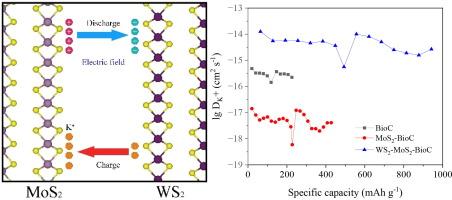当前位置:
X-MOL 学术
›
Appl. Surf. Sci.
›
论文详情
Our official English website, www.x-mol.net, welcomes your
feedback! (Note: you will need to create a separate account there.)
WS2-MoS2-biocarbon heterostructure for high-performance potassium ion storage
Applied Surface Science ( IF 6.3 ) Pub Date : 2024-11-19 , DOI: 10.1016/j.apsusc.2024.161843 Jiantao Wang, Chongxia Zhong, Qixin Yang, Jinsong Li
Applied Surface Science ( IF 6.3 ) Pub Date : 2024-11-19 , DOI: 10.1016/j.apsusc.2024.161843 Jiantao Wang, Chongxia Zhong, Qixin Yang, Jinsong Li

|
Potassium ion batteries (PIBs) have attracted increasing attention due to their inexpensive elemental potassium resources and excellent theoretical electrochemical properties. Two-dimensional metal sulfides exhibit a high specific capacity as potassium ion hosts, but the high diffusion barriers for potassium ions lead to a poor reversibility of the reaction and make the theoretical capacity difficult to achieve. Here, the sulphide MoS2 was introduced into WS2 nanosheets to construct layered WS2/MoS2 heterostructures anchored on a biogenic carbon (BioC) framework. The MoS2 in the framework served as an anchoring site to stabilise the intermediate product KxSy and to increase the WS2 layer spacing. Interfacial electric fields and potassium ion migration channels with high conversion reversibility were also formed in the layered heterostructures. The results confirmed that the reversibility of the reaction and the potassium ion diffusion rate were improved. As a result, the WS2-MoS2-BioC electrode achieves high specific capacity and diffusion rate, with a reversible specific capacity of up to 517.1 mAh g−1 at 0.1 A g−1, and a three order of magnitude improvement in potassium ion diffusion performance compared to that of MoS2-BioC. This heterostructure design strategy provides ideas for the development of metal sulphide anodes for potassium ion batteries.
中文翻译:

用于高性能钾离子储存的 WS2-MoS2-生物碳异质结构
钾离子电池 (PIBs) 因其廉价的元素钾资源和优异的理论电化学性能而受到越来越多的关注。二维金属硫化物作为钾离子主体表现出高比容量,但钾离子的高扩散势垒导致反应的可逆性差,难以达到理论容量。在这里,硫化物 MoS2 被引入 WS2 纳米片中,以构建锚定在生物碳 (BioC) 框架上的层状 WS2/MoS2 异质结构。框架中的 MoS2 用作锚定点,以稳定中间产物 KxSy 并增加 WS2 层间距。在层状异质结构中还形成了具有高转换可逆性的界面电场和钾离子迁移通道。结果证实,反应的可逆性和钾离子扩散速率都有所提高。因此,WS 2-MoS 2-BioC 电极实现了高比容量和扩散速率,在 0.1 A g-1 时具有高达 517.1 mAh g-1 的可逆比容量,与 MoS2-BioC 相比,钾离子扩散性能提高了三个数量级。这种异质结构设计策略为钾离子电池用金属硫化物负极的开发提供了思路。
更新日期:2024-11-19
中文翻译:

用于高性能钾离子储存的 WS2-MoS2-生物碳异质结构
钾离子电池 (PIBs) 因其廉价的元素钾资源和优异的理论电化学性能而受到越来越多的关注。二维金属硫化物作为钾离子主体表现出高比容量,但钾离子的高扩散势垒导致反应的可逆性差,难以达到理论容量。在这里,硫化物 MoS2 被引入 WS2 纳米片中,以构建锚定在生物碳 (BioC) 框架上的层状 WS2/MoS2 异质结构。框架中的 MoS2 用作锚定点,以稳定中间产物 KxSy 并增加 WS2 层间距。在层状异质结构中还形成了具有高转换可逆性的界面电场和钾离子迁移通道。结果证实,反应的可逆性和钾离子扩散速率都有所提高。因此,WS 2-MoS 2-BioC 电极实现了高比容量和扩散速率,在 0.1 A g-1 时具有高达 517.1 mAh g-1 的可逆比容量,与 MoS2-BioC 相比,钾离子扩散性能提高了三个数量级。这种异质结构设计策略为钾离子电池用金属硫化物负极的开发提供了思路。


















































 京公网安备 11010802027423号
京公网安备 11010802027423号